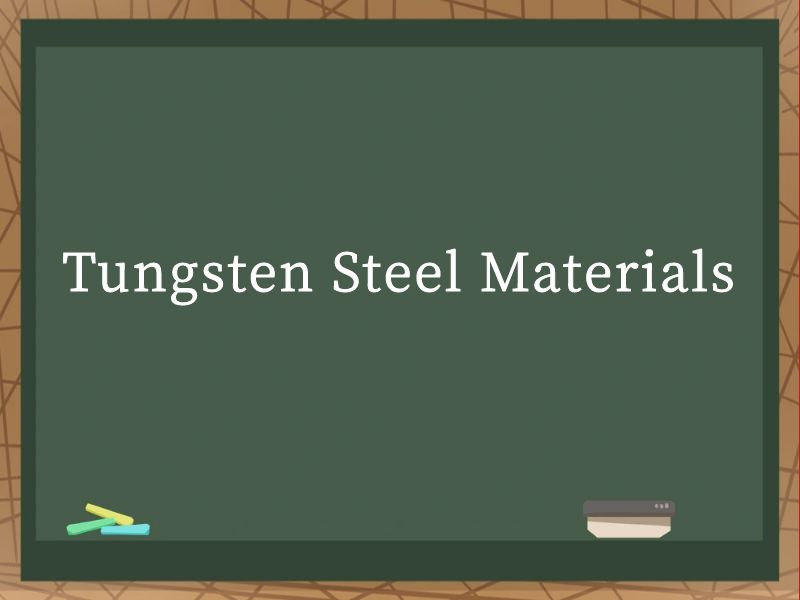JOURNALISM
- NEWS -
|
Tungsten Steel MaterialsTungsten Steel Materials.Tungsten steel, also known as tungsten carbide (WC), is a unique and highly valued material in the field of materials science and engineering. Its exceptional properties make it indispensable in various industries, ranging from cutting tools and drilling equipment to wear-resistant components and aerospace applications. This comprehensive overview aims to provide an in-depth understanding of tungsten steel materials, covering their composition, properties, manufacturing processes, applications, and future trends.
Introduction to Tungsten Steel Tungsten steel is a composite material primarily composed of tungsten carbide particles embedded in a cobalt (Co) or nickel (Ni) binder matrix. The combination of tungsten carbide's hardness and the binder's toughness results in a material with unparalleled wear resistance, hardness, and compressive strength. Tungsten, a rare metal with the highest density among all elements, plays a crucial role in enhancing these properties. Composition and Structure The composition of tungsten steel typically includes tungsten carbide (WC) particles and a metallic binder. The WC particles are responsible for the material's hardness and wear resistance, while the binder provides the necessary toughness and ductility to prevent brittleness. The most common binder materials are cobalt and nickel, although other alloys can also be used depending on specific application requirements. The microstructure of tungsten steel is characterized by a homogeneous distribution of WC particles within the binder matrix. This structure ensures that the material maintains its hardness and wear resistance while also exhibiting good mechanical properties. The size and distribution of WC particles, as well as the composition and content of the binder, significantly influence the overall performance of tungsten steel. Properties of Tungsten Steel Tungsten steel is renowned for its exceptional properties, which make it suitable for a wide range of applications. Some of its key properties include: High Hardness: Tungsten carbide is one of the hardest materials known, with a hardness approaching that of diamond. This property makes tungsten steel ideal for cutting and drilling applications where high wear resistance is crucial. Wear Resistance: Due to its high hardness and the uniform distribution of WC particles, tungsten steel exhibits excellent wear resistance. This makes it suitable for components that are subjected to abrasive and erosive wear. Compressive Strength: Tungsten steel has high compressive strength, which allows it to withstand heavy loads and pressures without deformation or failure. Toughness: The addition of a metallic binder, such as cobalt or nickel, enhances the toughness of tungsten steel. This makes it less brittle and more resistant to cracking under impact loads. Thermal Stability: Tungsten steel maintains its hardness and wear resistance at elevated temperatures, making it suitable for applications involving high-temperature environments. Corrosion Resistance: The material is relatively resistant to corrosion, especially in acidic and alkaline environments. However, its corrosion resistance can vary depending on the specific composition and application conditions. Manufacturing Processes The manufacturing of tungsten steel involves several key steps, including powder preparation, mixing, pressing, sintering, and post-processing. Here's a brief overview of these processes: Powder Preparation: Tungsten carbide powder is produced through various methods, such as carbon reduction of tungsten oxide or direct synthesis from tungsten and carbon sources. The powder size and purity are critical factors affecting the final properties of the material. Mixing: The WC powder is mixed with the binder powder (e.g., cobalt or nickel) in a controlled environment to ensure a homogeneous distribution. This step is crucial for achieving a uniform microstructure in the final product. Pressing: The mixed powder is pressed into the desired shape using various molding techniques, such as isostatic pressing or die pressing. The pressing pressure and temperature are carefully controlled to avoid defects in the molded material. Sintering: The pressed material is then sintered at high temperatures (typically around 1400-1500°C) in a controlled atmosphere to achieve the final density and microstructure. The sintering process consolidates the powder particles and forms a strong bond between the WC particles and the binder matrix. Post-processing: After sintering, the material may undergo additional processing steps, such as grinding, polishing, or coating, to meet specific application requirements. Applications of Tungsten Steel Tungsten steel's unique properties make it an ideal choice for a variety of applications across different industries. Some of the most common applications include: Cutting and Drilling Tools: Tungsten steel is widely used in the manufacturing of cutting tools, such as drills, milling cutters, and turning tools. Its high hardness and wear resistance allow for efficient machining of hard materials with minimal tool wear. Wear-resistant Components: Components subjected to abrasive and erosive wear, such as nozzles, valves, and pumps, often benefit from the use of tungsten steel. Its ability to withstand wear and maintain performance under harsh conditions makes it a reliable choice for these applications. Mining and Construction Equipment: In the mining and construction industries, tungsten steel is used in drills, crushers, and other equipment that requires high hardness and wear resistance. This helps to improve the efficiency and durability of these machines. Aerospace and Defense: Tungsten steel's high compressive strength and thermal stability make it suitable for applications in the aerospace and defense sectors, such as engine components, armor plating, and missile casings. Medical Instruments: Its corrosion resistance and biocompatibility make tungsten steel a viable option for medical instruments and implants that require high durability and reliability. Future Trends and Developments As technology advances and industrial demands evolve, the use of tungsten steel is expected to continue growing. Some of the future trends and developments in this field include: Advanced Manufacturing Techniques: The development of new manufacturing techniques, such as additive manufacturing (3D printing), could enable the production of complex tungsten steel components with higher precision and lower costs. Enhanced Properties: Researchers are continuously working on improving the properties of tungsten steel through innovative alloying and processing methods. This includes the development of new binder materials and the optimization of WC particle size and distribution. Sustainability: Efforts are being made to develop more environmentally friendly manufacturing processes for tungsten steel, as well as to recycle and reuse tungsten-containing materials to reduce waste and resource consumption. New Applications: As the properties and manufacturing capabilities of tungsten steel continue to improve, new applications in emerging fields, such as renewable energy and nanotechnology, are expected to emerge. Tungsten steel, with its exceptional hardness, wear resistance, and compressive strength, is a versatile material with a wide range of applications. From cutting tools and mining equipment to aerospace components and medical instruments, tungsten steel plays a crucial role in many industries. As technology progresses and new manufacturing techniques are developed, the use of tungsten steel is likely to expand further, driving innovation and efficiency in various sectors. With ongoing research and development efforts, the future of tungsten steel materials looks promising, with new applications and enhanced properties continuously being explored and realized. |


